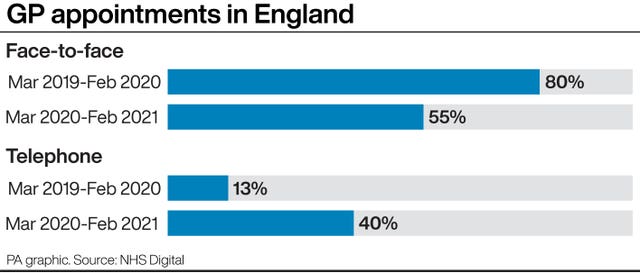37m fewer GP appointments during pandemic, figures suggest
The figures came in an analysis of experimental figures from NHS Digital.

There have been nearly 37 million fewer GP appointments in England since the start of the coronavirus pandemic, data suggests.
An analysis of experimental figures from NHS Digital, published on Thursday, shows that in the 12 months from March 2020 there were an estimated 275 million GP appointments in England.
This is around 12% fewer than the estimated 312 million in the previous 12 months.
Prime Minister Boris Johnson announced the first national lockdown on March 23 2020.

The estimated number of appointments in England dropped year-on-year every month between March 2020 and February 2021, except September when it rose by 2% compared with the same month of 2019.
The biggest year-on-year falls were in April and May during the first national lockdown – down 32% and 33% respectively compared with the same months the previous year.
NHS Digital said the decline in appointments did not mean GPs were necessarily having fewer interactions with patients because of practices operating differently during the pandemic.
It added there could have been an increase in the use of list appointments, where several patients are contacted but only one appointment slot appears in the collected data.
The data from December onwards also contains appointments related to Covid-19 vaccinations, NHS Digital said.
Professor Martin Marshall, chair of the Royal College of GPs, said: “We know that during the first lockdown there was a drop-off in general practice consultations being delivered, which is reflected in this data.
“This could have been down to various factors, including patients being reluctant to seek medical care for fear of contracting Covid-19 or concerns that they were being a burden on the NHS during the pandemic, or a lack of clarity around ‘stay at home’ guidance.
“However, by last summer GP consultation rates were around or exceeding normal levels.
“We also need to remember that counting consultation numbers is a rather blunt measure of workload in general practice that doesn’t account for complexity of consultations, which has increased during the pandemic with, on average, nearly three problems being presented at each visit.”
The analysis, by the PA news agency, also found that during the 12 months from March last year the proportion of GP appointments carried out face-to-face was 55%.
This is a drop from 80% in the previous 12 months.
The proportion of appointments carried out by telephone rose from 13% to 40%.
The highest proportion of telephone appointments was 47.9% in April – the month after the the first national lockdown was announced.
In April, May and June there were more telephone appointments than face-to-face consultations.
Sir Robert Francis QC, chair of Healthwatch England, said: “If people cannot get through to a GP, not only can their health and wellbeing be put at risk, but demand on already overstretched hospitals gets worse.
“People will go to A&E if there is nowhere else to go, and their condition may deteriorate, leading to an increased treatment and care, because they couldn’t get help sooner.
“The shift to remote care during the pandemic has understandably happened extremely quickly, but there is little evidence that people have been consulted about how they view these changes.
“As we move out of the pandemic, thanks to the success of the vaccination programme, the NHS has a great chance to address how people choose to access GP services, as well as continuing the improvements brought about by new ways of offering the service.”





